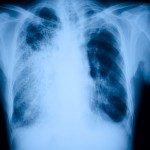
Because of a more favourable side effects profile (not necessarily clinical superiority), second-generation antipsychotics (SGAs) are today the most commonly used drugs to treat psychotic disorders such as schizophrenia (Jones et al., 2006).
While rather frequent adverse reactions, including weight gain, diabetes or sedation, are largely recognised, recent studies point at increased risk of pneumonia in SGA treatment.
To aggregate more statistically sound knowledge on the association between SGAs and pneumonia, Kuo et al. (2013) have published a case-control study of a large cohort of people with schizophrenia.
Methods
Built on governmental medical and health insurance records, the authors selected patients with at least one psychiatric hospitalisation between 2000 and 2008, but not earlier (in line with market introduction of SGAs). From these, 33,024 patients between 18 and 65 years with a diagnosis of schizophrenia were extracted as the cohort.
Cases were defined as patients who developed pneumonia that required hospitalisation after first psychiatric admission (1,741) and compared to 6,949 matched controls. Critical period of SGA exposure was set to 30 days before hospitalisation for pneumonia.
Results

Clozapine was associated with a three-fold increased risk of pneumonia
- The overall incidence of pneumonia in the study population was 1.12 cases/100 person-years
- In general, current SGA treatment increases overall risk of developing pneumonia by 69%. Recent or past use (prescription ended 31-180 or more than 180 days before pneumonia-related hospitalisation) did not confer an increased risk
- This was strongest in case of clozapine, which was associated with an 318% (adjusted risk ratio of 3.18) greater risk of developing pneumonia
- Olanzapine (RR 1.83), quetiapine (RR 1.63), zotepine (RR 1.48), risperidone (RR 1.32) but not amisulpride (RR 1.14) were associated with significantly increased risks
- In the case of clozapine, there was evidence of a dose-dependent association
- First-generation antipsychotics (e.g. haloperidol) were not associated with pneumonia requiring hospitalisation
Conclusions
The authors conclude that:
Accordingly, we found that clozapine was associated with high risk of pneumonia, that olanzapine, quetiapine, zotepine, and risperidone were associated with moderate risk, and that amisulpride was associated with low risk of developing pneumonia.
Limitations
Treatment adherence was not assessed, so it is possible that some patients (especially when considering low individual tolerability of some antipsychotics) stopped taking their drugs. While this would, as Kuo et al. (2013) mention, most likely have resulted in an underestimated effect size, discontinuation symptoms might affect the results in a myriad of different ways.

Confounding variables such as smoking were not controlled for in the analysis
What is more, some important confounding variables were not controlled for in the analysis. For instance, there is no information on tobacco history, which is itself is associated with pneumonia (Almirall et al., 1999).
Likewise, the fact that only pneumonia cases requiring hospitalisation were assessed, biases the sample towards extreme cases (and most likely more elderly patients).
Unfortunately, only cases with schizophrenia were included in the analysis, even though SGAs are also commonly prescribed in other disorders, including bipolar disorders or sometimes eating disorders. Scientifically speaking, the risk increases described by Kuo and colleagues are therefore limited to schizophrenic cases only.
Summary
This case control study underlines the need to fully inform patients about all possible side effects before starting SGA treatment. Especially during the first 30 days of treatment, patients should be more closely monitored for signs of respiratory pathology and pneumonia. While this risk is most pronounced with clozapine (and therefore most severely affects patients with treatment-resistant psychotic disorders), all other SGAs should not be neglected in patient care, irrespective of the diagnosis they are prescribed for.
Links
Kuo, C.-J., Yang, S.-Y., Liao, Y.-T., Chen, W.J., Lee, W.-C., Shau, W.-Y., et al. (2013). Second-generation antipsychotic medications and risk of pneumonia in schizophrenia. Schizophrenia Bulletin, 39(3), 648-657. [Abstract]
Almirall, J., Gonzalez, C.A., Balanzo, X., & Bolibar, I. (1999). Proportion of community-acquired pneumonia cases attributable to tobacco smoking (PDF). Chest, 116, 375-379.
Jones, P.B., Barnes, T.R., Davies, L., Dunn, G., Lloyd, H., Hayhurst, K.P., et al. (2006). Randomized controlled trial of the effect on Quality of Life of second- vs first-generation antipsychotic drugs in schizophrenia: Cost Utility of the Latest Antipsychotic Drugs in Schizophrenia Study (CUtLASS 1) (PDF). Arch Gen Psychiatry, 63(10), 1079-87.


Newer antipsychotics may increase the risk of pneumonia in schizophrenia: Because of a more favourable side ef… http://t.co/JsqOfsqvoU
Newer antipsychotics may increase the risk of pneumonia in schizophrenia http://t.co/tAgGxcyXVj via @sharethis
New case control study finds clozapine is associated with a 3 fold increased risk of pneumonia http://t.co/EmGZ1EJreT #schizophrenia
Newer anti-psychotics associated not only with poor cardiovascular health but risk of pneumonia as well? http://t.co/TwTgJmNaxS @Mental_Elf
MT“@Mental_Elf: Newer antipsychotics may increase the risk of pneumonia http://t.co/b7WApuW7va”: dysphagia or smoking a contributing factor?
Olanzapine, quetiapine, zotepine & risperidone also associated with increased risk of pneumonia http://t.co/EmGZ1EJreT #schizophrenia
@Mental_Elf that due to the drugs or that people taking those drugs more likely to smoke/ poor physical health?
If you’re taking anti-psychotics, take care of your lungs! There’s an increased risk of pneumonia http://t.co/hxf2whR6Zy By @Mental_Elf
Amisulpride & first generation antipsychotics (e.g. haloperidol) not associated with increased risk of pneumonia http://t.co/EmGZ1EJreT
@Mental_Elf but truly madly deeply unpleasant to take.
Newer antipsychotics may increase the risk of pneumonia in schizophrenia – The Mental Elf http://t.co/KLdmha6udl
Schizophrenia patients should be more closely monitored for signs of respiratory pathology and pneumonia http://t.co/EmGZ1EJreT
Atypische antipsychotica geassocieerd met longontsteking. Behalve Amilsulpiride (helaas nog steeds niet in NL) http://t.co/h9jkmXxyAh
In case you missed it earlier: Newer antipsychotics may increase the risk of pneumonia in schizophrenia http://t.co/EmGZ1EJreT
@Mental_Elf Weight gain, erectile dysfunction NOW pneumonia – how much more will we have to deal with.
@Mental_Elf important research. One of my patients died of clozapine associated pneumonia
@SameiHuda @Mental_Elf thats awful. So sorry to hear that. Is there any postulated mechanism? Nothing to do with hypersalivation?
@mark_bolstridge @Mental_Elf for clozapine I suspect hyper salivation.
Mental Elf: Newer antipsychotics may increase the risk of pneumonia in schizophrenia http://t.co/Ir4PDbM8uY
Misschien is dát dan een reden om het eundelijk in NL toe te laten? Amisulpride does not increase risk of pneumonia http://t.co/NYo2STyWZD
Re: The Mental Elf, Newer antipsychotics may increase the risk of pneumonia in schizophrenia, October 31st 2013.
Thank you for posting about the risk of pneumonia in patients who have lived experiences with schizophrenia and are currently taking antipsychotics. After seeing your numbers, it prompted me to have a closer look at the nested case control study itself (Kuo et al. 2013).
For me to get my head around the clinical importance of the findings I needed to think about the findings in terms of absolute risk difference or number needed to treat. Fortunately, with this being a nested CCS, we can make these estimates based on the data provided.
Using the reported baseline risk of 1.12 cases of pneumonia/100 person-years I estimated the rates of hospitalization due to pneumonia in current users of specific antipsychotic agents (only for those with a statistically significant increase):
ARD/yr NNTH/yr
Clozapine:RR=3.18 x 1.12 cases/100 p-y 2.4% 41
Olanzapine:RR=1.83 x 1.12 cases/100 p-y 0.93% 108
Quetiapine:RR=1.63 x 1.12 cases/100 p-y 0.71% 141
Risperidone:RR=1.32 x 1.12 cases/100 p-y 0.36% 278
In words, clozapine use increases the risk of hospitalization due to pneumonia by 2.4% per year. That is, for every 41 people receiving clozapine vs. no antipsychotic there is an added hospitalization for pneumonia each year. If this is true this is clinically important, in my opinion.
However, I do question the VALIDITY of the findings. A concern is that a large proportion of people with pneumonia were included more than once. There were 1739 people with pneumonia (cases) but when the number of cases of pneumonia per antipsychotic are summed the total is 2045. Some people who are at higher risk for pneumonia may be at higher risk for being on an antipsychotic (for other confounding reasons that were not adjusted for). The fact that ~38% of people are being double counted could bias the results. The findings could be dramatically different if each person was restricted to their first admission to hospital for pneumonia and then censored thereafter to avoid exaggerating this confounder.
Lastly, you mentioned that clozapine increased the risk of hospitalization due to pneumonia by 318%. This isn’t quite accurate. It increased the risk, relatively, by 218% of what the risk would otherwise be. It is accurate to say the risk was increased approximately 3 fold.
I think it is important to also note that an Australian group conducted a study using a slightly different method (self-controlled case-series analysis) to look at the association between antipsychotic use and pneumonia in 2011 (http://www.ncbi.nlm.nih.gov/pubmed/21663332). While they did find a higher risk shortly after the AP was started, the highest risk for pneumonia (and for hip fracture) was at its maximum shortly BEFORE the AP was started. A great illustration of confounding by indication. This implies that the Kuo study from Taiwan may be similarly confounded by unmeasured factors.